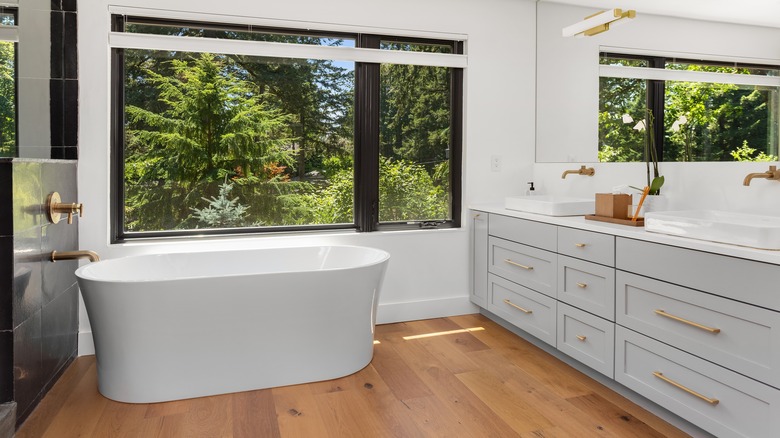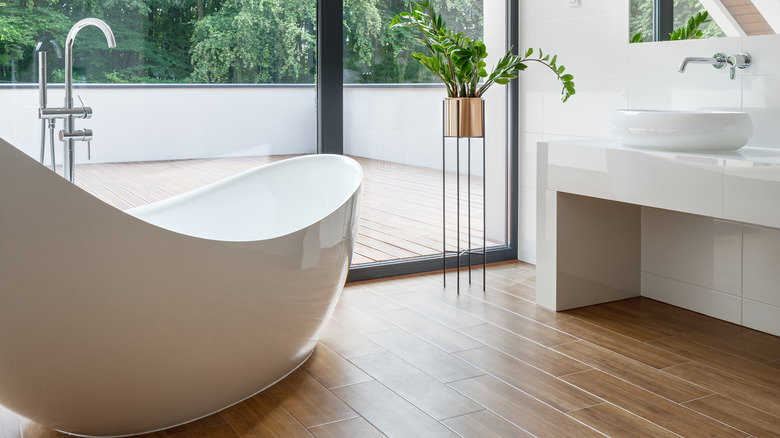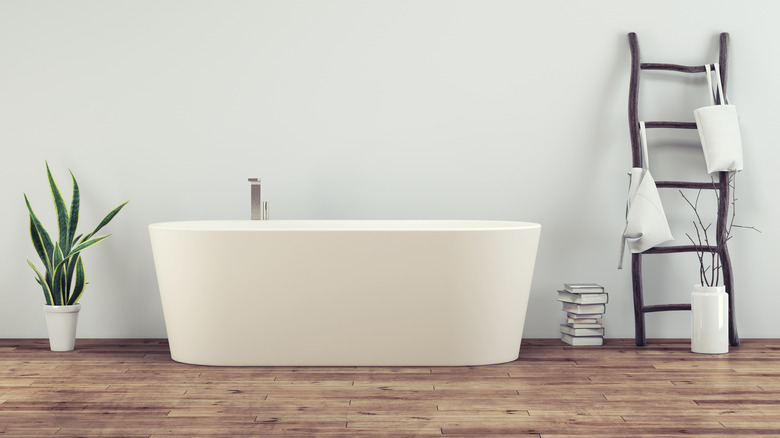Waterproof Vinyl Vs. Tile: What's The Best Bathroom Option For That Chic Hardwood Floor Look
Hardwood floors are beloved by homeowners for their durability, clean look, and the warmth it brings to a space. However, certain areas of our homes, like bathrooms, experience such high humidity and moisture that hardwood floors languish in these conditions. Susceptible to warping, cracking, discoloration, mold, and mildew, it's wise to avoid this material in our bathrooms. Not to mention, we use so many different bath salts, soaps, and shampoos that are harmful to wood flooring alone. But don't worry; you can achieve the same chic style through wood-look tile and waterproof vinyl flooring.
Each has its own set of pros and cons to consider, but these faux hardwood options come in various colors, styles, and textures and completely eliminate the worry of water damage. With wood-look tile, you'll find more durability but a more challenging installation and a higher price. With waterproof vinyl, you'll get a lower cost and more accessible application but less resilience. It's crucial to weigh all factors of each alternative and contemplate the size and condition of your space when making a final decision.
Wood-look tile
Wood-look tile is exactly what it sounds like — ceramic or porcelain tile resembling natural hardwood flooring. The perk of choosing tile over other hardwood alternatives is that it's one of the most durable materials, lasting between 75 to 100 years if maintained and cared for properly. You can choose from several types of designs and colorways, and the grout can be hidden well to improve an authentic timber appearance. However, you should be cautious when selecting offset patterns. Wood-look tiles are not flat and apex in the center, causing frequent lippage to occur. You often run the risk of tiles setting in different elevations with offset patterns, but it is still a risk with all kinds of wood-look tiles.
Due to its already uneven configuration, there may be better options than this if you have unlevel flooring. If your bathroom is not level, you can still apply this tile to your floors, but the installation process will be much more challenging and expensive as you have to balance out all divots and peaks beforehand. Without counting the grout and setting costs, wood-like tile ranges between $1.50 to $3 per square foot, which is much less expensive than traditional hardwood. Prices will vary depending on whether you choose ceramic or porcelain, with porcelain being the more expensive of the two. You will also likely need to hire a professional for this task unless you have prior experience in laying tile and the complexities that can come with it.
Water-proof vinyl
Water-proof vinyl is well-loved for its easy installation, simple care, and great ability to keep water from penetrating the floor. This is often a go-to option for many DIYers as it is affordable and pretty straightforward to lay in place. Vinyl can be installed through glued-down options, click-together systems, and as adhesive planks. Glued-down vinyl tends to be harder to remove but is best for larger surface areas, so this may be an alternative for those planning long-term situations. Click-together is typically harder to repair if damaged, and tile vinyl is known to be relatively uncomplicated to apply.
Water-proof vinyl flooring is more expensive than wood-like tile, priced from $5.50 to $12 per square foot based on the quality of the vinyl you're using. However, even though the price per square foot may be higher than tile, you are avoiding the cost of grout, mortar, and professional help by installing vinyl. Vinyl may not be as durable as tile. It has a softer exterior and can be discolored by the sun and damaged by objects dragging along its surface, but it still lasts a plentiful 10 to 20 years. Overall, water-proof vinyl is the better choice if you are seeking a DIY project and a more affordable option. But, wood-look tile will be just as lovely and provide more longevity if you find it worth the hassle.


